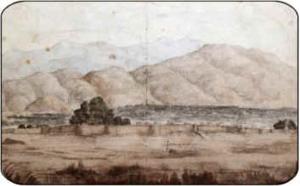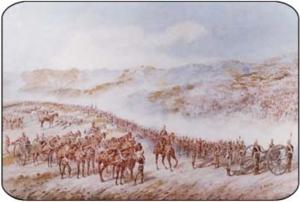(13th Regiment of Foot - Prince
Albert's)
The Earl of Huntingdon's Regiment of
Foot - 1685

The Earl of Huntingdon's Regiment of
Foot - 1685
In 1685, King James II of England, recognising the
threat to his throne from the Duke of Monmouth, commissioned
Theophilus, the 7th Earl of Huntingdon, to raise a Regiment
of foot soldiers. This Regiment was to be known as the
Earl of Huntingdon's Regiment and would eventually be
called the Somerset Light Infantry.
The Earl of Huntingdon commanded the Regiment for 3
years. In 1688 the Army transferred its allegiance to
King William of Orange - the Protestant King who succeeded
James II. At the same time, the Catholic Earl handed
over command of the Regiment to Ferdinand Hastings,
who was a Protestant, and the Regiment, following the
custom of Regiments to be called after the name of their
Commanding Officer, took the title of Hastings' Regiment.
It was also known as the 13th Regiment of Foot.
The regiment's first battle was at Killiekrankie in
1689. This was a defeat for the English, but Hastings'
Regiment is reported to have distinguished itself and
was the only English regiment to stand fast amid the
general rout of King William's forces.
The first Battle Honour was that of 'Gibraltar' when
the Regiment, under the command of the Earl of Barrymore,
played its part in the raising of the Siege of Gibraltar
in 1705. Whilst serving in the War of Spanish Succession,
the C-in-C (the Earl of Peterborough) ordered that the
role of the Regiment should be changed from that of
foot soldiers to cavalry. From 1706-1713, the Regiment
was on horse-back and was called Pearce's Dragoons.
In 1725, Lord Mark Kerr became the Colonel-in-Chief.
Some 55 years later, a direct descendant of Kerr also
became the Colonel of the Regiment (and was responsible
for handing over the Burma Memorial, which stands in
the centre of the town, to the Borough Council of Taunton).
Pearce's Dragoons 1707-13

Pearce's Dragoons 1707-13
Under Colonel Pulteney the Regiment took part in the
Battle of Dettingen (1743) - the last battle in which
the English Sovereign led his troops into battle. It
also took part in the famous Battle of Culloden in 1746
- the last battle to be fought on British soil - when
the English Army defeated the Scots under Bonnie Prince
Charlie. It is thought that the English C-in-C, the
Earl of Cumberland, was so impressed with the performance
of the Regiment that he gave instructions for the senior
NCOs to wear their sashes over their left shoulders
(similar to the Officers). This unique tradition still
exists in the successor Regiment today, although its
true origin is still in some doubt.
In about 1752, regiments of the British Army ceased
to be called by the name of their Commanding Officer.
They took instead their seniority number in the line.
In the case of this Regiment, it was known as the 13th
Regiment of Foot. Although in 1766 the Regiment had
its first connection with the Royal family when HRH
The Duke of Gloucester became Colonel of the Regiment,
it was not until 1782 that the Regiment was first officially
connected to the County of Somerset. King George II
decreed that all Regiments should be affiliated to a
particular Territorial area of the country. The 13th
of Foot thus became known as the 1st Somersetshire Regiment.
During the Napoleonic Wars, the Regiment found itself
on the periphery of the main conflict areas. In 1801
it took part in the assault landing at Aboukir Bay in
Egypt, when a combined British Naval and Army force
defeated Napoleon's troops and captured Alexandria.
This was yet another battle Honour and the Regiment
was also accorded the distinction of wearing the Sphinx
in its cap badge and the name 'Egypt' appeared in the
centre of the Regimental Colour. Service in Egypt was
followed by further fighting in the French West Indies
when the islands of Martinique and Guadeloupe were captured.
The Regiment was then sent to Canada in 1813 where it
was involved in the war with the United States of America,
which had invaded Canada. It was, in fact, in North
America that it first used Light Infantry tactics to
good effect. In 1822, on Christmas Day, the Regiment
was accorded the significant privilege of being appointed
a Light Infantry Regiment.

Major Robert ("fighting bob")
Sale rescues a soldier from a Burmese Chief at Rangoon
8th July 1824
It was also in 1822 that the Regiment was posted to
India where it was later required to take part in the
Burmese War (1824-26). This was the start of an extraordinary
link with the Indian continent. From then on, apart
from a few short periods, there was always one of the
Regiment's Battalions serving on the Indian continent.
Indeed, the Regiment was to be the last British unit
to leave India after its Independence in February 1948.
Of all the Battle Honours bestowed upon the Regiment
none surpasses that of 'Jellalabad'. The Regiment was
besieged by a greatly superior force of Afghans in the
town of Jellalabad from November 1841 to April 1842.
The conduct of the Regiment during the siege and the
courage and resilience of all ranks was legendary. After
the relieving force failed to reach the town which had
by now been turned into a fortress, the decision was
taken to break out. This was successfully accomplished
on 7th April 1842 when the Regiment (together with a
Bengal Native Regiment) defeated an Afghan rebel force
estimated to be six times greater in number.

Original sketch of Jellalabad June
1842
News of the courageous breakout soon reached
England. Queen Victoria was so impressed that she ordered
that the Regiment should henceforth be known as 'Prince
Albert's Regiment of Light Infantry' after her Consort.
The Queen also approved the change of colour of the
Regiment's uniform facings from yellow to royal blue.
A special campaign medal was struck to commemorate the
siege. The name 'Jellalabad' would appear in a scroll
at the top of the Regimental badge and the badge would
also contain a mural crown (referring to the fortress
walls of Jellalabad) and the initials 'PA' (Prince Albert).
In Parliament, the Prime Minister, Robert Peel, referred
to the Regiment as the 'Illustrious Garrison'.
The Regiment next saw active service in the Crimean
War and played its part in suppressing the Indian Mutiny.
It was at Azimgurh in 1858 that the Regiment earned
its first two Victoria Crosses. They were awarded to
Pte Patrick Carlin and Sgt William Napier - both for
exceptional bravery in rescuing wounded colleagues under
heavy enemy fire. It was also in 1858 that the Regiment
formed its 2nd battalion at Winchester.
The 1st Battalion fought in the Zulu War (1877-79)
when, at the Battle of Ulundi, it carried its Colours
into battle for the last time. Maj William Knox Leet
was awarded the Victoria Cross during this campaign.
In 1885-87 the 2nd Battalion saw its first action when
it took part in the Burma War. A memorial to all those
members of the Regiment who lost their lives in this
conflict was erected by the Regiment and now stands
in the centre of Taunton, having been moved to its present
position in 1997. Meanwhile in Taunton a new Barracks
was built on the site of an old and rather smaller Barracks.
This new Barracks was known as Jellalabad Barracks.
Apart from the Keep, which still stands much as it has
ever done, most of the Barracks has been demolished
and new housing, has been built on the site.

The 13th Light Infantry at the Battle
of Ulundi - 1879. The Battalion firing in line flanked
by artillery
The British Army found itself short of available troops
to go to South Africa in 1899 to fight in the Boer War.
The 2nd Battalion of the Regiment was deployed there
and so were some members of the West and North Somerset
Yeomanry (the equivalent of the TA). Even some members
of the Somerset Militia were sent to South Africa -
an extremely rare event for a Militia unit. Then came
the Great War (1914-18). The Regiment formed no less
than 19 Battalions. Many fought in Europe, but there
were also some which were sent to India and the Middle
East. The Regiment suffered nearly 5000 casualties as
a result of the Great War. One member, Pte Tom Sage,
of the 8th Battalion was awarded the Victoria Cross.
In the Second World War the Regiment formed 10 Battalions.
The 1st Battalion was in India and saw service in Burma.
One of its Officers, Lt George Cairns, whilst on attachment
to the South Staffordshire Regiment won a posthumous
Victoria Cross fighting against the Japanese. The 2nd
Battalion fought in the Italian Campaign and later in
Greece. It was in Italy where Maj Gen John Harding started
to show prominence as Chief of Staff to General Alexander.
Harding was to go on to be Field Marshal The Lord Harding
of Petherton - the Regiment's most famous son. The 4th
and 7th Battalions landed in Normandy 2 weeks after
D-Day and fought their way through France, Belgium and
Holland with the 43rd Wessex Division. At the end of
the war both Battalions were in the area of Bremen having
suffered terrible casualties. The 10th Battalion was
re-roled as a Parachute battalion in 1942. It landed
on the canal and river bridges north of Caen in the
early hours of D-Day and was to see further action as
the North-West Europe campaign progressed.

Field Marshal Lord Harding of Petherton
GCB CBE DSO MC - Died 20/01/1989.
On 28th February 1948, the 1st Battalion The Somerset
Light Infantry marched through the Gateway of India in
Bombay after having taken part in a huge ceremonial Parade.
The Battalion was the last British unit to leave India
after it had received its Independence in August 1947.
It was during this Parade that the Regiment was presented
with a magnificent silver replica of the Gateway of India
by the Army of India. This magnificent item of silver
can be seen in the Military Museum in the Castle in Taunton.
The Battalion returned by troopship to Liverpool where
they received a hero's welcome as, indeed, they received
in Taunton, when they arrived there by train a day later.
The 2nd Battalion was disbanded in 1948 as part of
the Government's post-war defence cuts. In 1952, after
some intensive training in Germany, the lst Battalion
was deployed to Malaya for a 3 year tour of duty fighting
against the Communist terrorists in the jungle. The
Battalion had a most successful tour of duty in that
theatre. This was followed by counter-insurgency operations
in Cyprus (where Field Marshal Harding was the Governor)
in 1956. The anti-tank platoon also saw action in the
Suez Operation in 1956. In 1959, at Warminster, the
Regiment carried out its final Parade before amalgamation
with the Duke of Cornwall's Light Infantry to become
the Somerset and Cornwall
Light Infantry.
The Regiment survives today as The 2nd Battalion The
Light Infantry

Somerset Light Infantry Regimental
Association
Contact: 14 Mount Street, Taunton, Somerset, TA1 3QE,
Tel: 01823 333434 ext 663 or 665 |

